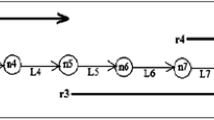Abstract
In this paper, we study the problem of radio resource allocation, both transmission rates and transmission powers, so as to maximize the throughput of UWB wireless ad-hoc networks. Our analysis is based on the packet-success function (PSF), which is defined as the probability of a data packet being successfully received as a function of the receiver’s signal-to-interference-and-noise-ratio (SINR). We find an optimal link transmission rate, which maximizes the link’s throughput and is dependent on the all active links transmission powers. If each link transmission rate is adapted to this optimal link transmission rate, then, with single-link operation (i.e., no other interference sources are present), the link’s throughput is directly proportional to the transmitter’s power and increases indefinitely with increasing transmission power. However, with multiplelinks operation and interference each other, as each link transmitting power increases, so does the interference level, and the total network throughput approaches a constant other than infinite. Thus, for sufficiently small transmission power, the total network throughput of the multiple-links case exceeds the throughput of the single-link case, but the reverse happens for high power. In addition, this paper reveals that, as the number of concurrently transmitting links increases, regardless of the power level, the maximal total network throughput approaches a constant, with each link’s throughput approaching zero. To maximize the network throughput, for the case of small maximal transmission power with weak interference levels, the optimal transmission scheduling allocates simultaneous transmissions of multiple links, but for the case of large maximal transmission power with strong interference levels, the optimal policy assigns separate time for transmission on each link. The breakpoint of when to use one link or multiple links is termed the critical power. As an example of the analytical calculation of the critical link’s power, we present here solutions for a two-link case and an N-link case. In contrast with previous studies, our results imply that the design of optimal MAC is dependent on the choice of a routing scheme.
Similar content being viewed by others
References
Apsel A, Dokania R, Wang X. Ultra-low power radios for ad-hoc networks. In: IEEE International Symposium on Circuits and Systems, Taipei, 2009. 1433–1436
Tang X, Hua Y. Capacity of ultra-wideband power-constrained ad hoc networks. IEEE Trans Inf Theory, 2008, 54: 916–920
Zou C, Haas Z. Optimal resource allocation for UWB wireless ad hoc networks. In: IEEE 16th International Symposium on Personal, Indoor and Mobile Radio Communications, Berlin, 2005. 452–456
Radunovic B, Le Boudec J Y. Optimal power control, scheduling, and routing in UWB networks. IEEE J Sel Area Commun, 2004, 22: 1252–1270
Merz R, Le Boudec J Y, Widmer J, et al. A rate-adaptive MAC protocol for low-power ultra-wide band ad-hoc networks. In: Proceeding of 3rd International Conference on AD-HOC Networks and Wireless, Vancouver, 2004. 306–311
Liu K H, Cai L, Shen X. Exclusive-region based scheduling algorithms for UWB WPAN. IEEE Trans Wirel Commun, 2008, 7: 933–942
Cuomo F, Martello C, Baiocchi A, et al. Radio resource sharing for ad hoc networking with UWB. IEEE J Sel Area Commun, 2002, 20: 1722–1732
Baldi P, De Nardis L, Di Benedetto M G. Modeling and optimization of UWB communication networks through a flexible cost function. IEEE J Sel Area Commun, 2002, 20: 1733–1744
Tsirigos A, Haas Z J. Analysis of multipath routing—Part I: The effect on the packet delivery ratio. IEEE Trans Wirel Commun, 2004, 3: 138–146
Win M, Scholtz R. Ultra-wide bandwidth time-hopping spread spectrum impulse radio for wireless multiple-access communications. IEEE Trans Commun, 2000, 48: 679–691
Feng D, Ghauri S, Zhu Q. Application of the MUI model based on packets collision (PC) in UWB ad-hoc network. In: International Conference on Networking, Sensing and Control, Okayama, 2009. 554–558
Durisi G, Romano G. On the validity of Gaussian approximation to characterize the multiuser capacity of UWB TH PPM. In: Proceeding of IEEE Conference of Ultra-Wideband Systems Technologies, Baltimore, 2002. 151–161
Molisch A F. Ultrawideband propagation channels—theory, measurement, and modeling. IEEE Trans Veh Technol, 2005, 54: 1528–1545
Ghassemzadeh S S, Tarokh V. UWB path loss characterization in residential environments. In: Proceeding of IEEE Radio Frequency Integrated Circuits (RFIC) Symposium, Philadelphia, 2003. 501–504
Zhu S, Leung K K, Constantinides A G. Distributed cooperative data relaying for diversity in impulse-based UWB ad-hoc networks. IEEE Trans Wirel Commun, 2009, 8: 4037–4047
Kaiser T, Zheng F, Dimitrov E. An overview of ultra-wide-band systems with MIMO. Proc IEEE, 2009, 97: 285–312
Author information
Authors and Affiliations
Corresponding author
Rights and permissions
About this article
Cite this article
Zou, C., Haas, Z.J. & Zou, S. Throughput maximization in UWB-based ad-hoc networks. Sci. China Inf. Sci. 53, 2538–2547 (2010). https://doi.org/10.1007/s11432-010-4120-8
Received:
Accepted:
Published:
Issue Date:
DOI: https://doi.org/10.1007/s11432-010-4120-8




